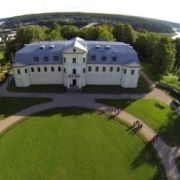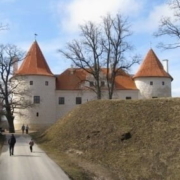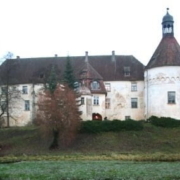Windau Castle
 Windau Castle in Ventspils is considered the oldest fortress of the late Middle Ages in Latvia (1290), preserved in such full volume. The mouth of the Venta River was first mentioned in historical sources in 1263, in connection with the conclusion of an agreement on the division of the port of Kurzeme and the Curonian lands between the Master of the Livonian Order and the Bishop of Kurzeme. This area became the property of the Livonian Order. Crusaders at the end of the XIII century. (from 1263 to 1290) a stone castle of Windau was erected here, 1 km from the mouth of the Venta River. There are suggestions that this could happen already in the middle of the century. The oldest part of the Order Castle, built on the site of the former Kurish fortification, was a free-standing donjon tower to protect a good sea harbor and navigation along the Vente River in the 13th century. It is possible that originally the castle was surrounded by a moat, but its traces have not survived to this day.
Windau Castle in Ventspils is considered the oldest fortress of the late Middle Ages in Latvia (1290), preserved in such full volume. The mouth of the Venta River was first mentioned in historical sources in 1263, in connection with the conclusion of an agreement on the division of the port of Kurzeme and the Curonian lands between the Master of the Livonian Order and the Bishop of Kurzeme. This area became the property of the Livonian Order. Crusaders at the end of the XIII century. (from 1263 to 1290) a stone castle of Windau was erected here, 1 km from the mouth of the Venta River. There are suggestions that this could happen already in the middle of the century. The oldest part of the Order Castle, built on the site of the former Kurish fortification, was a free-standing donjon tower to protect a good sea harbor and navigation along the Vente River in the 13th century. It is possible that originally the castle was surrounded by a moat, but its traces have not survived to this day.
In 1290, the Master of the Order of Halt approved the borders of the Kuldiga and Ventspils Commissions, and it was then that the Vindau Castle was first mentioned in historical sources as a ready-made structure in which the commander of the Livonian Order lived. According to historians, Windau Castle was built in three stages, the so-called three construction periods. Initially, before 1290 a square tower of 10x16x30 m was built with a total area of about 1133 square meters, as well as a fortress wall surrounding it with a side length of 32.5 x 33.5 m around a courtyard of about 160 square meters. m. The wall thickness was about two meters. For the inhabitants of the castle, the tower served as the last refuge at the time of danger, so the entrance to the tower was arranged at a safe height from the ground, where access was via a rapidly ascending wooden staircase. On the second floor there was a room where you could sit out in case of siege. To keep warm, the knights stoked the fireplace.
Over time, Windau Castle became the center of the corresponding commerce. About 21 komturs from 1291 or 1309 to 1560 are known who lived in the Ventspils castle during the entire existence of the state of the Livonian Order. The first commander was Brother Detlev or Detfler, who was mentioned in 1291. From the revision protocol dated 1442, it is mentioned that five knights, two priests live in the castle, they had weapons for 32 people and 34 horses. Of the ammunition in the castle there were also 6 cannons and 20 self-arrows with 30 arrows of arrows (30×60 pcs.) And a half-barrel of gunpowder. In 1451, seven order brothers, commanders, and service staff lived in the castle.
In the 14th century, all the buildings of the castle were built, forming a complex of buildings such as a convention with a courtyard. During the Polish-Swedish war (1655-1660) the castle was destroyed, and in the second half of the 17th century it was rebuilt again.
In 1832, the reconstruction of the castle was completed, and the period of its use as a district prison began, which lasted until 1959. After that, the castle was used as the base of the military unit of the border forces of the USSR. In 1997, the facade of the castle was updated and its territory was landscaped. Outwardly, the castle was restored to its historical appearance – now it looks like in the 19th century.
Windau Castle these days:
Now the castle houses the Ventspils Museum, whose exposition is about the history of the castle, the city and the port. The developed exposition using computer technology is considered the most modern in the Baltic States. For example, in the Castle Ghost Cellar, you can see the Black Piglet of a castle running past, and in the exposition “In Prison” you can hear the voices of prisoners. In the courtyard, where various events are often held, you can shoot from a real bow.












Leave a Reply
Want to join the discussion?Feel free to contribute!